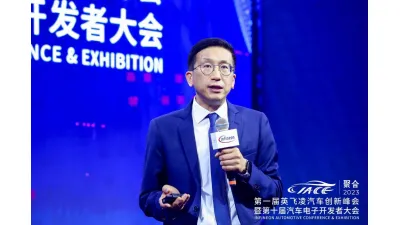Korea announced the launch of the
South Korea's first deputy Minister of Trade, Industry and Energy stressed that scattered small-scale projects run by a few experts can neither produce significant results nor outperform competitors in the technology race. At the same time, he said his department would "set up a research and development system with guidance from Korea's top experts and a 'dream team' of innovation leaders to create tangible results".
Jang Young-jin, the first Vice minister of Trade, Industry and Energy, announced the launch of the "Industrial Transformation Super Gap Project" at the roundtable of Chief Technology officers of the Korea Chamber of Commerce and Industry on April 10.
The conference was organized by LX Semicon, the global leader in Display driver chips (DDI), incorporated by a subsidiary of LX Holdings, which was spun off from LG, Samsung Display, Hyundai Motor, POSCO, Yujin Robot, one of the world's largest steel manufacturers, LG Innotek, an electronics component maker, LG's subsidiary), L&F (South Korea's largest producer of cathode materials for lithium-ion batteries), Hanwha Aerospace (South Korea's only aero-engine manufacturer), CJ CheilJedang (CJ Cheiljedang, It was attended by the heads of four related organizations, including the core subsidiary of CJ Group's food and bioengineering division, and the CTO of nine companies.
At the meeting, Zhang stressed that scattered, small-scale projects run by a few experts can neither produce significant results nor outperform competitors in the technology race. At the same time, he said his department would "set up a research and development system with guidance from Korea's top experts and a 'dream team' of innovation leaders to create tangible results".
The Super Gap Project is a government project to nurture the super gap growth of Korea's local industries and realign the R&D system to a goal-oriented and results-driven system, while setting investment directions and support mechanisms for the realization of the 12 national strategic technologies and the New Growth Strategy 4.0.
The Super Gap project will be promoted from the following three directions:
First, the public and private sectors will define the objectives and direction of investment in each area and focus investment on selected strategic projects.
Until now, there has been concern that the direction of government R&D investment is unclear, with most projects and missions tending to simply "follow suit." To address this issue, the Ministry of Trade, Industry and Energy (MOTIE), together with related companies, expert groups and think tanks, has selected 40 projects to achieve 34 tasks in 11 core investment areas.
The 11 investment sectors are semiconductors, display, batteries, future mobility, core materials, intelligent robots, high-tech manufacturing, aerospace and defense, next-generation nuclear energy, high-tech biotechnology and new energy industries.
In semiconductors, three tasks and four projects have been selected. In order to implement the first task (" power in high-tech system chips "), two projects will be launched: 1) development of composite power semiconductors for mobile, energy, and home appliances, and 2) development of semiconductor technology for autonomous vehicles (level 4 or above).
The second task (" Fostering the world's top 10 reprocessing enterprises ") has been selected to start the basic technology development project of high-tech semiconductor packaging.
The third task (" Supporting the semiconductor supply chain to remain super-gap competitive ") will be to build a small fab for early commercial demonstrations of 12-inch high-tech semiconductor wafers known as Mpes (materials, components and devices).
About 70 percent of the New Year s R&D budget will be allocated to selected projects. The government plans to invest 6.2 trillion won by 2027 and 13.5 trillion won by 2030 through preliminary feasibility studies and procurement of new projects.
The second is to grant project management rights to top experts in the market and industry.
Previously, a project was overseen and planned by a project manager from each business category. Once the planning phase was completed, the project manager's responsibility ended and no one remained to oversee the process.
However, all phases of the Super Gap project are overseen not only by the project director, but also by a team of project managers made up of market and industry experts who will be involved in setting project objectives, developing technology, training people and evaluating results.
Once the project management team is established, plan details regarding setting goals, project organization, and milestones will be further finalized.
Past research and development projects, consisting of many small-scale missions in which individual entities performed their own tasks, have been criticized for their meager results compared to the success of individual missions.
Nine companies and four agencies participating in the roundtable signed memorandums of understanding (Mous) for the implementation of the Super Gap Project. The company will actively set up a project manager team and a strategic planning team to support the management of technological innovation alliance. Stressing that scattered, small-scale projects carried out by a few experts can neither produce significant results nor outperform competitors in the technology race, Vice Minister Zhang said the ministry will "set up a research and development system with top experts from South Korea providing guidance and support." Innovation leaders can form a 'dream team' to create tangible results."
A memorandum of understanding (MOU) on the implementation of the Supergap project was signed by nine companies and four organisations. Each enterprise will actively set up a project manager team and a strategic planning team to support the management of technological innovation alliance.
The Korea Institute of Industrial Technology Evaluation and Planning (KEIT) and the Korea Institute of Energy Technology Evaluation and Planning (KETEP) will assist the project management team, while the Korea Institute of Technology Development (KIAT) will assist in personnel training and basic projects.
Data centers and their supply chains are facing an energy crisis
The energy crisis has pushed the price of electricity and other energy sources to their highest levels in 100 years. As the operating costs of data center enterprises are rising, reducing power co…Taiwan's technology industry saw its slowest revenue drop in a decade in March
Taiwan's leading technology companies saw their revenues fall the most in at least a decade in March, according to the Nikkei Asian Review, signaling a looming slump in demand for chips and other …China has made important breakthroughs in the research and development of 6G communication technology
China has made important breakthroughs in the research and development of 6G communication technology. According to the second Academy of Aerospace Science and Industry, 25 institutes of the Second…Infineon Technologies: Seize low-carbon and digital opportunities, strive to be the
Intellectualization, low carbonization and digitalization are important trends of automobile industry development. Infineon is a global leader in automotive electronics, power systems, IoT and oth…
- Top News
- HRE CSA Series Commercial Grade MLCC Capacitor Selection Guide
- HRE CIA Series Industrial Grade MLCC Capacitor Selection Guide
- HRE CAA/CAI Series Automotive Grade MLCC Capacitor Selection Guide
- FTR20D681K Varistor Applications and Technical Advantages: Providing Comprehensive Protection for Your Circuits
- Samsung Electronics showcases its new automotive technology strategy at Foundry Forum EU 2023



